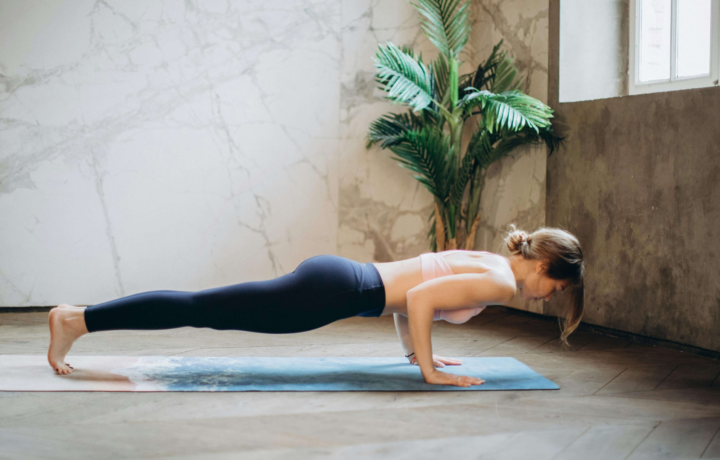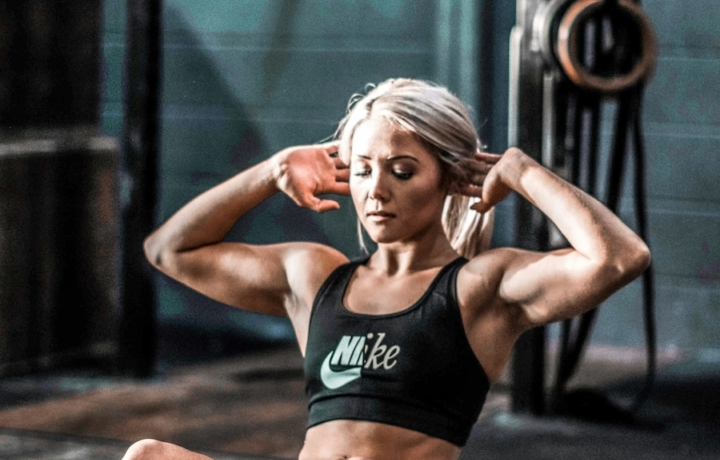Exercise
Russian Twist

Russian Twist
How to Perform
- Sit on the floor with your knees bent and feet flat on the ground, elevating your upper body to create a V-shape with your thighs.
- Extend your arms straight in front of your chest with hands clasped together or holding a weight.
- Engage your core muscles by drawing your navel toward your spine and slightly lean back until you feel your abdominals activate.
- Lift your feet a few inches off the ground while maintaining balance through your sitting bones, creating tension in your midsection.
- Inhale deeply and on the exhale, rotate your torso to the right, bringing your hands or weight toward the floor beside your hip.
- Maintain a tall spine and avoid collapsing through the chest or shoulders during the rotation.
- Return to center with control, then rotate to the left side while keeping your feet elevated and core engaged.
- Continue alternating sides in a controlled manner, exhaling on each rotation and inhaling as you return to center.
Important information
- Keep your back straight throughout the movement – avoid rounding your shoulders or hunching forward.
- If you're a beginner, start with feet on the floor and work up to elevated feet as your core strength improves.
- Control the movement rather than using momentum – slower, more deliberate twists provide better core engagement.
- If you experience any lower back pain, reduce the range of motion or keep your feet on the ground to decrease the difficulty.

Russian Twist
Exercise Details
Primary Muscles
Muscle Groups
Mechanic
Risk Areas
Built for progress
Take the guesswork out of training
Create personalized AI-powered workout plans that evolve with you. Train smarter, track every rep and keep moving forward, one workout at a time.






The Russian Twist stands as a cornerstone exercise in core training, targeting not just the rectus abdominis but placing significant emphasis on the obliques—those muscles that define the sides of your waistline. This intermediate-level movement has earned its place in diverse training methodologies, from high-intensity interval training (HIIT) and CrossFit circuits to traditional bodybuilding routines, proving its versatility across fitness disciplines.
What makes the Russian Twist particularly effective is its rotational component, which mimics real-world movements we perform daily. Unlike standard crunches or sit-ups that work in a single plane of motion, this exercise challenges your core through a twisting action that enhances functional strength and stability. Your obliques must fire continuously throughout the movement, making this an efficient way to develop that coveted torso definition while building practical strength.
The beauty of the Russian Twist lies in its scalability. Fitness enthusiasts can modify the intensity by adjusting leg position, increasing the rotation range, or incorporating weights to progressive overload the core musculature. This adaptability explains why it remains a staple in core-focused training segments across experience levels, though beginners should master proper form before advancing to weighted variations.
Beyond aesthetic benefits, regular incorporation of Russian Twists into your routine contributes significantly to core stability, which serves as the foundation for nearly all athletic movements. A strong, stable core translates to improved performance in other lifts, better posture, and reduced risk of lower back injuries—a testament to this exercise's functional importance.
For those dedicated to comprehensive core development, the Russian Twist provides that crucial rotational strength often neglected in conventional ab routines. When programmed appropriately—typically for moderate to high repetitions—this movement delivers both the muscle engagement necessary for hypertrophy and the endurance component essential for functional fitness, making it truly one of the most complete core exercises available.
FAQ - Russian Twist
The Russian Twist primarily engages the obliques (side abdominals) while also activating the rectus abdominis (six-pack muscles) and transverse abdominis (deep core). Additionally, it works the hip flexors and erector spinae as stabilizing muscles during the rotational movement.
For an easier variation, keep your feet on the floor or perform the movement with bent knees. To increase difficulty, elevate your feet completely off the ground, extend your legs, increase the rotation range, or add weight (medicine ball, dumbbell, or weight plate).
The most common mistakes include rounding the lower back instead of maintaining a straight spine, moving only the arms rather than rotating from the torso, rushing through repetitions, and using momentum instead of controlled movement. Focus on initiating the twist from your core while keeping your chest up.
Incorporate Russian Twists 2-3 times weekly as part of your core training, allowing at least 48 hours between sessions for muscle recovery. Start with 2-3 sets of 10-15 rotations per side, gradually increasing volume as your core strength improves.
Russian Twists can place strain on the lower back if performed incorrectly. If you have existing back problems, start with a modified version keeping feet on the floor, maintain proper form with a neutral spine, and consider consulting a physical therapist or fitness professional before adding this exercise to your routine.









